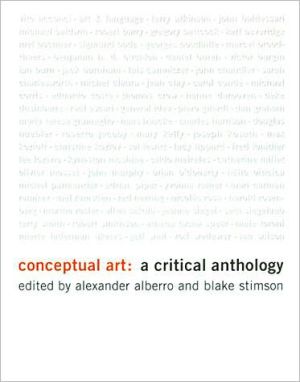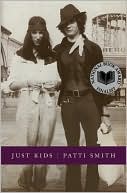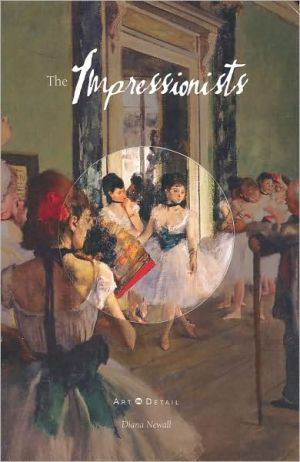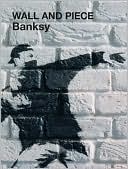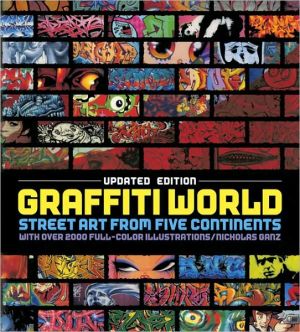Conceptual Art: A Critical Anthology
Compared to other avant-garde movements that emerged in the 1960s, conceptual art has received relatively little serious attention by art historians and critics of the past twenty-five years—in part because of the difficult, intellectual nature of the art. This lack of attention is particularly striking given the tremendous influence of conceptual art on the art of the last fifteen years, on critical discussion surrounding postmodernism, and on the use of theory by artists, curators, critics,...
Search in google:
This landmark anthology collects for the first time the key historical documents that helped give definition and purpose to the conceptual art movement.Library JournalThese two compilations, one a show catalog, the other an anthology of artists' writings, review one of the most contested movements in 20th-century art. While the editors may quibble over certain key points--such as the founding moment of conceptualism--their works largely complement rather than contradict each other. In Conceptual Art, art history professors Alberro and Stimson present a rich history of the American branch through the writings of Joseph Kosuth, Lucy Lippard, the Art & Language collective, and dozens of others. The editors' selections concentrate on the manifestos and critiques produced during the movement's formative years from 1966 to 1977--in fact, they seem to regard later artists as impure hangers-on--but they also have included memoirs and a few retrospective histories. In addition, two introductions trace the movement's history and analyze the true aims of the adherents. Reading these primary texts is essential to understanding such an intellectually grounded movement; one only hopes a more affordable paperback will be issued for students. The catalog to a show that will be moving from New York to Minneapolis and Miami, Global Conceptualism aims to broaden our understanding of conceptual art by showing its varied manifestations in different cultures at different times. The show's organizers are careful to indicate that these manifestations are not necessarily part of a cohesive whole, intimating instead that conceptualism is a logical response to certain political conditions that have reappeared in various places. Reinforcing this basic understanding, the book presents 11 geographically oriented essays. The pieces are always informative, but their parameters vary widely, and the quality of the writing is rather uneven. These are supplemented by 70 pages of plates, a chronology, and brief biographies of the artists. Neither book is for the uninitiated, thanks largely to the complexity of the subject matter, but they are both clear and unique contributions. All academic and large public libraries should stock both.--Eric Bryant, "Library Journal" Copyright 1999 Cahners Business Information.
IllustrationsPrefaceReconsidering Conceptual Art, 1966-1977The Promise of Conceptual ArtI1966-1967A Media Art (Manifesto)2Compositions for Audio Structures6Position and Program8Paragraphs on Conceptual Art12Excerpt from Placement as Language (1928)18The Serial Attitude22Statement28Buren, Mosset, Toroni or Anybody30Remarks on Air-Conditioning: An Extravaganza of Blandness32A Defense of the "Conceptual" Process in Art36General Scheme of the New Objectivity40II1968The Dematerialization of Art46Concerning the Article "The Dematerialization of Art"52Statement60Statement to Lucy Lippard62Interview with Daniel Buren: Art Is No Longer Justifiable or Setting the Record Straight66Tucuman Burns76III1969Paris Commentary82Painting Is Obsolete88Art Workers' Coalition Open Hearing Presentation92Introduction98Sentences on Conceptual Art106Dialogue110Dialogue Piece112Maintenance Art Manifesto, Proposal for an Exhibition, "CARE"122Patron's Statement for "When Attitudes Become Form"126Politics and the Avant-Garde128Art Tamed and Wild136Introduction to Konzeption/Conception142Beware144Art After Philosophy158Introduction to 557,087178IV1970Conceptual Art as Art188Excerpts from Speculation (1967-1970)192On Exhibitions and the World at Large198Notes Towards Art Work204Introduction to Art in the Mind210Introduction to Information212Alice's Head: Reflections on Conceptual Art216De-aestheticization220Contemporary Colonial Art224Insertions in Ideological Circuits232V1971-1974Interview with Lawrence Weiner236An Interview with Hans Haacke242Rules of Thumb248Propositions258Interview with Art-Language262The Trouble with Art-as-Idea268Cultural Confinement280Production for Production's Sake284L'art conceptual286Postface, in Six Years: The Dematerialization of the Art Object, 1966 to 1972294In Support of Meta-Art298All the "Art" That's Fit to Show302VI1975-1977A Declaration of Dependence308The Art Market: Affluence and Degradation3201975334Having-Your-Heart-in-the-Right-Place-Is-Not-Making-History350The Timeless Lumpenness of Radical Cultural Life354To Be bien pensant ... or Not to Be. To Be Blind358Documentary and Corporate Violence360To Argue for a Video of Representation. To Argue for a Video Against the Mythology of Everyday Life366Notes on Reading the Post-Partum Document370Moments of History in the Work of Dan Graham376VIIMemoirs of Conceptual ArtThe 'Sixties: Crisis and Aftermath (or the Memoirs of an Ex-Conceptual Artist)392Statements410Conceptual Art414My Works for Magazine Pages: "A History of Conceptual Art"418On Conceptual Art424Statement426Yes, Difference Again: What History Plays the First Time Around as Tragedy, It Repeats as Farce428Working with Shadows, Working with Words432We Aimed to Be Amateurs442A Conversation About Conceptual Art, Subjectivity and the Post-Partum Document450Intention(s)460Inside a New York Art Gang: Selected Documents of Art & Language, New York470Statement486"Dada - Situationism/Tupamaros - Conceptualism": An Interview with Luis Camnitzer492VIIICritical Histories of Conceptual ArtDan Graham's Kammerspiel504Conceptual Art 1962-1969: From the Aesthetic of Administration to the Critique of Institutions514Conceptual Art and Critical Judgement538The Logic of Modernism546Blueprint Circuits: Conceptual Art and Politics in Latin America550Unwritten Histories of Conceptual Art564
\ Library JournalThese two compilations, one a show catalog, the other an anthology of artists' writings, review one of the most contested movements in 20th-century art. While the editors may quibble over certain key points--such as the founding moment of conceptualism--their works largely complement rather than contradict each other. In Conceptual Art, art history professors Alberro and Stimson present a rich history of the American branch through the writings of Joseph Kosuth, Lucy Lippard, the Art & Language collective, and dozens of others. The editors' selections concentrate on the manifestos and critiques produced during the movement's formative years from 1966 to 1977--in fact, they seem to regard later artists as impure hangers-on--but they also have included memoirs and a few retrospective histories. In addition, two introductions trace the movement's history and analyze the true aims of the adherents. Reading these primary texts is essential to understanding such an intellectually grounded movement; one only hopes a more affordable paperback will be issued for students. The catalog to a show that will be moving from New York to Minneapolis and Miami, Global Conceptualism aims to broaden our understanding of conceptual art by showing its varied manifestations in different cultures at different times. The show's organizers are careful to indicate that these manifestations are not necessarily part of a cohesive whole, intimating instead that conceptualism is a logical response to certain political conditions that have reappeared in various places. Reinforcing this basic understanding, the book presents 11 geographically oriented essays. The pieces are always informative, but their parameters vary widely, and the quality of the writing is rather uneven. These are supplemented by 70 pages of plates, a chronology, and brief biographies of the artists. Neither book is for the uninitiated, thanks largely to the complexity of the subject matter, but they are both clear and unique contributions. All academic and large public libraries should stock both.--Eric Bryant, "Library Journal" Copyright 1999 Cahners Business Information.\ \
